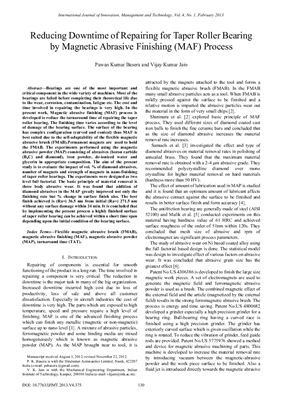Статья. Опубликована в журнале "Inteational Joual of
Innovation, Management and Technology". – 2013. – Vol. 4, No.1 – P.
130-136.
Статья на английском языке.
Название на русском языке: Сокращение простоев на ремонт для
конических роликовых подшипников за счет магнитно-абразивной
финишной обработки (МАО).
Аннотация к статье на английском языке:
Bearings are one of the most important and critical component in the wide variety of machines. Most of the bearings are failed before completing their theoretical life due to the wear, corrosion, contamination, fatigue etc. The cost and time involved in repairing the bearings is very high. In the present work, Magnetic abrasive finishing (MAF) process is developed to reduce the tuaround time of repairing the taper roller bearing. The finishing time varies according to the level of damage of the bearing surface. The surface of the bearing has complex configuration (curved and conical) thus MAF is best suited due to the self-adaptability of the flexible magnetic abrasive brush (FMAB).Permanent magnets are used to hold the FMAB. The experiments performed using the magnetic abrasive powder (MAP) consisting of abrasives (boron carbide (B4C) and diamond), iron powder, de-ionized water and glycerin in appropriate composition. The aim of the present study is to evaluate the impact of vol. % of diamond abrasives, number of magnets and strength of magnets in nano-finishing of taper roller bearings. The experiments were designed as two level full factorial. The basic principle of material removal is three body abrasive wear. It was found that addition of diamond abrasives in the MAP greatly improved not only the finishing rate but % change in surface finish also. The best finish achieved is (Ra=) 36.5 nm from initial (Ra=) 271.5 nm without any surface damage within 24 min. It is concluded that by implementing the present process a highly finished surface of taper roller bearing can be achieved within a short time span depending upon the initial condition of the bearing surface.
Bearings are one of the most important and critical component in the wide variety of machines. Most of the bearings are failed before completing their theoretical life due to the wear, corrosion, contamination, fatigue etc. The cost and time involved in repairing the bearings is very high. In the present work, Magnetic abrasive finishing (MAF) process is developed to reduce the tuaround time of repairing the taper roller bearing. The finishing time varies according to the level of damage of the bearing surface. The surface of the bearing has complex configuration (curved and conical) thus MAF is best suited due to the self-adaptability of the flexible magnetic abrasive brush (FMAB).Permanent magnets are used to hold the FMAB. The experiments performed using the magnetic abrasive powder (MAP) consisting of abrasives (boron carbide (B4C) and diamond), iron powder, de-ionized water and glycerin in appropriate composition. The aim of the present study is to evaluate the impact of vol. % of diamond abrasives, number of magnets and strength of magnets in nano-finishing of taper roller bearings. The experiments were designed as two level full factorial. The basic principle of material removal is three body abrasive wear. It was found that addition of diamond abrasives in the MAP greatly improved not only the finishing rate but % change in surface finish also. The best finish achieved is (Ra=) 36.5 nm from initial (Ra=) 271.5 nm without any surface damage within 24 min. It is concluded that by implementing the present process a highly finished surface of taper roller bearing can be achieved within a short time span depending upon the initial condition of the bearing surface.

